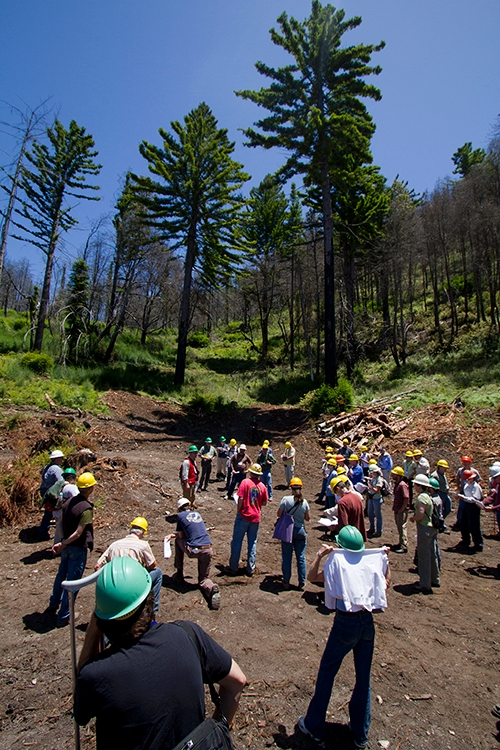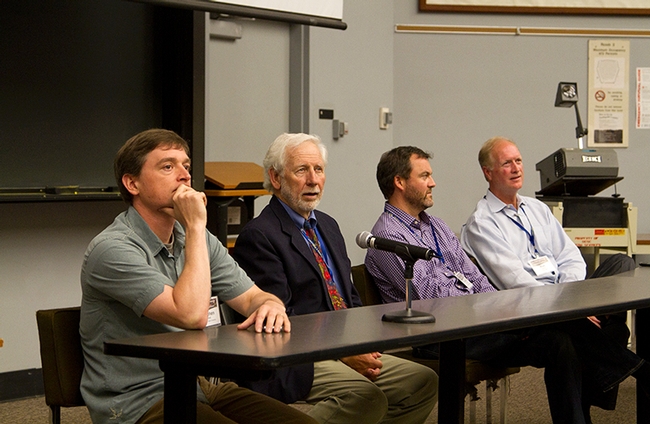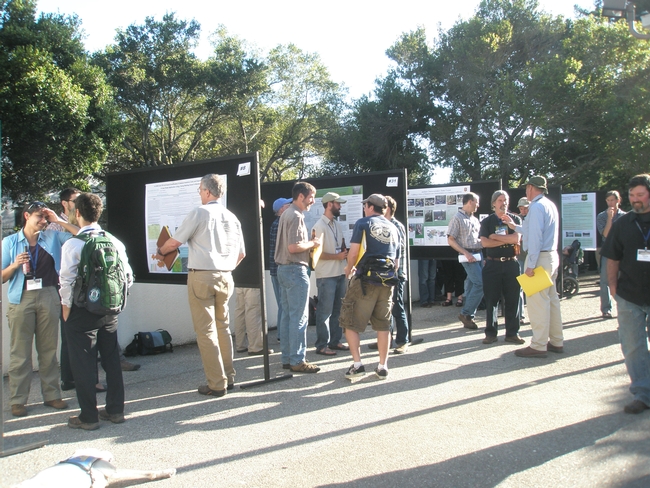Introduction
The Coast Redwood Forests in a Changing California Science Symposium was held June 21-23, 2011 at UC Santa Cruz with just under 300 registrants in attendance. Participants ranged in background from graduate level students to university forestry faculty, land managers, and conservation groups, public agencies, and land trust members. The symposium was strategically held in Santa Cruz, near the Southern end of the redwood region. Designed to present the state of our knowledge about California’s coast redwood forest ecosystems and sustainable management practices, this symposium was built on earlier redwood science symposia held in Arcata, CA in June, 1996 and in Santa Rosa, CA in March, 2004.
Seed funding for the Symposium was from the University of California/California State University competitive grant program. Rick Standiford of UC Berkeley, Doug Piirto of Cal Poly San Luis Obispo, and John Stuart of Humboldt State Univeristy served as the three co-chairs of the symposium.
Link to Proceedings
The Proceedings were produced as a General Technical Report of the USDA Forest Service It is available on-line as well as a limited number of printed copies from the USDA Forest Service Pacific Southwest Research Station. The entire Proceedings or individual papers can be downloaded by clicking HERE. The full citation for the Proceedings is:
Standiford, Richard B.; Weller, Theodore J.; Piirto, Douglas D.; Stuart, John D, technical coordinators. 2012. Proceedings of coast redwood forests in a changing California: A symposium for scientists and managers. Gen. Tech. Rep. PSW-GTR-238. Albany, CA: Pacific Southwest Research Station, Forest Service, U.S. Department of Agriculture. 626 p.
Field Tour Information
The first day of the symposium consisted of two simultaneous field tours, one to the North County and one to the South County. The North County tour focused on active redwood timber management on corporate ownerships operating under the unique policies that dictate decision making on the central coast, and Cal-Poly’s forest management and research at its Swanton Pacific Ranch. It also included, a brief tour of the Big Creek Lumber Company sawmill and a visit to areas burned in the more than 7,000 acre Lockheed Fire of 2009. The South County tour traversed the range of redwood forest conditions from the old growth of Henry Cowell State Park and the uncut 120 year old young growth of Nisene Marks State Park to uneven-aged young growth stands established by individual tree selection harvesting on non-industrial forestlands.

Formal Presentations
Opening remarks started the second day of the symposium and began the academic concurrent sessions. Local historian Sandy Lydon spoke about the special history of the redwoods in the region, recounting stories from his boyhood about roaming through the forests and giving a brief synopsis of the settlement of the area. Steve Sillett, Humboldt State University forestry professor, described his experiences climbing the redwoods and his discoveries in the redwood forest canopy ecosystems, as well as his findings on tree growth from dendrochronology measurements. Ruskin Hartley, Executive Director and Secretary of Save the Redwoods League, called on the audience to set “audacious goals and collaborative actions.” He maintained that nature does not develop boundaries and that in moving forward, we should focus on a shared set of goals and that public and private land should progress simultaneously. Concluding the session, Ron Jarvis, Home Depot’s VP of sustainability talked candidly about the role of environmental sustainability practices and policies as part of the home improvement retailer’s business model. He noted that when he began in the sustainability department he undertook a two year long project to understand where every sliver of wood from over 9,000 products originated to ensure sustainable wood practices.

Over 75 concurrent oral presentations were showcased over two days, pertaining to the topics of: Ecology (15 presentations); Silviculture and Restoration (11 presentations); Watershed and Physical Processes (22 presentations); Wildlife, Fisheries, Aquatic Ecology (10 presentations); Forest Health (10 presentations); Economics and Policy (6 presentations); Monitoring (7 presentations). In addition, almost 40 posters were displayed during the evening reception, ranging in topic from post-fire response, to long-term watershed research, and community forestry models. Held outside on the warm Santa Cruz evening, participants enjoyed a strolling dinner and networking with colleagues, making the reception a highlight of the symposium.

Conclusions and Summary
The symposium concluded with closing remarks about the future of research in the redwood region from John Helms, UC Berkeley and Mike Liquori, Sound Watershed. In addition, a panel including Dan Porter, the Nature Conservancy, Lowell Diller, Green Diamond, and Kevin O’Hara, UC Berkeley discussed the interface of research, management, and conservation. The overall discussion led to the conclusion that academic research and applied research should be made available to the field as a whole as findings progress and that more opportunities for networking and interactions should be made available to the forestry community.
Overall, the symposium fulfilled its purpose to identify key knowledge gaps, bring together multi-disciplinary teams, and help identify future opportunities for collaboration. Participants were pleased with the presenters and research shown. Many noted that a highlight of the symposium was being able to meet and interact with others whose works they had previously cited in their own research. Of the approximately one half of participants who completed the follow-up survey, 100% hoped to see more events like the 2011 Redwood Symposium.